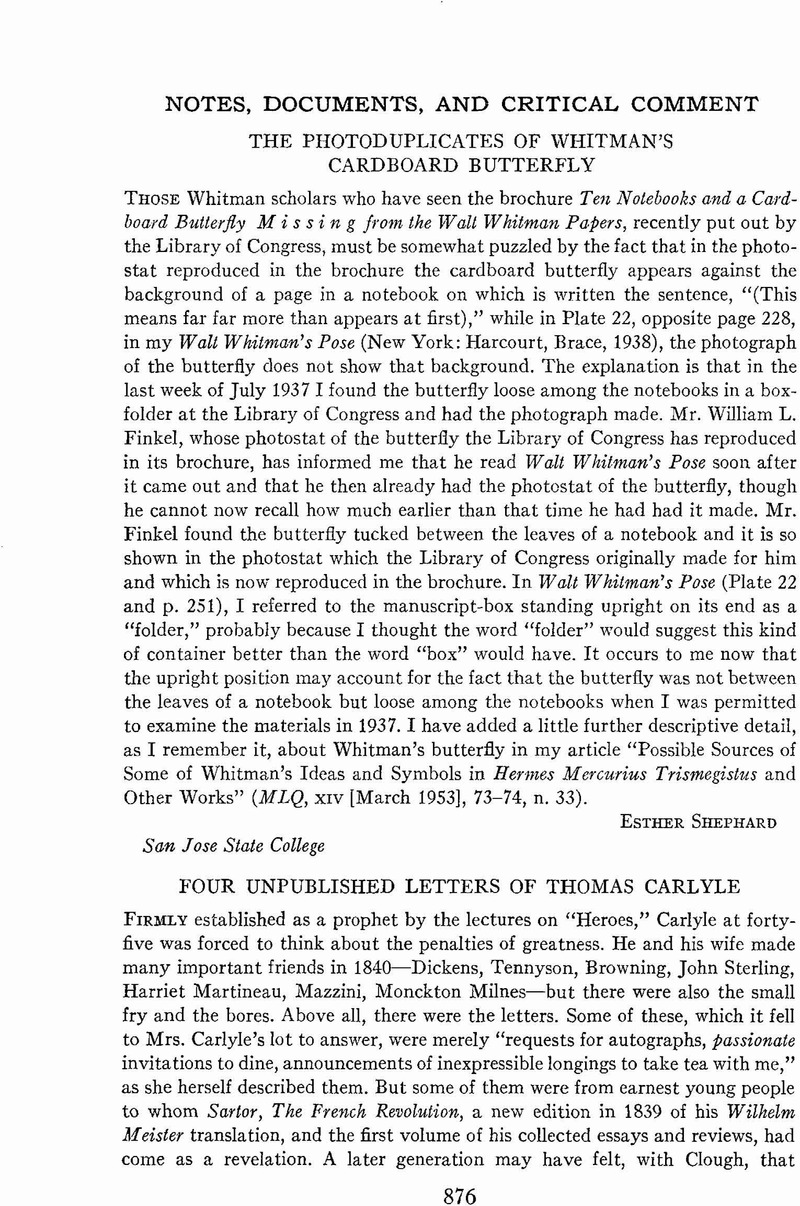No CrossRef data available.
Article contents
Four Unpublished Letters of Thomas Carlyle
Published online by Cambridge University Press: 02 December 2020
Abstract

- Type
- Notes, Documents, and Critical Comment
- Information
- Copyright
- Copyright © Modern Language Association of America, 1955
References
Note 1 in page 877 Alexander Wilson, Carlyle on Cromwell and Others (London, 1925), pp. 207–210. But for an exception to this practice, made in favor of the author of Mark Rutherford, who was suffering from doubt and hypochondria in 1850, see William Hale White, Pages from a Journal (London, 1900), p. 3. White was evidently fortified by the brusque admonition in Carlyle's answer: “Be not surprised that ‘people’ have no sympathy with you.”
Note 2 in page 877 1809–80. See Susanne Howe, Géraldine Jewsbury, Her Life and Errors (London: Allen and Unwin, 1935). The originals of her letters to Carlyle are in the writer's possession, and are dated 6 and 18 April 1840; 8 and 30 June 1840; 25 Aug., 5 Oct., 24 Nov. 1840; 25 Jan. 1841.
Note 3 in page 877 See Eric Gillett, Maria Jane Jewsbury (London: Oxford Press, 1932). Maria Jane was born in 1800 and died in India in 1833.
Note 4 in page 877 Francis Espinasse evidently followed her example. He and a friend wrote to Carlyle in 1841 naively requesting a “solution to the mystery of existence.” Carlyle's answer from Scotsbrig, Ecclefechan, 28 Aug. 1841, is in much the same tone as these letters of his to Miss Jewsbury. See Espinasse, Literary Recollections (London: Hodder and Stoughton, 1895), p. 58.
Note 5 in page 878 1820–95, son of the geologist, Algernon Gideon Mantell. Walter Mantell took the letters back with him when he returned to New Zealand in 1859 after a 4-year sojourn in England. They are in the Mantell Collection of the Turnbull Library in Wellington, New Zealand. Literal transcriptions of them were made available to the writer many years ago through the kindness of Waldo H. Dunn of Scripps College, Claremont, Calif.
Note 6 in page 879 See Caroline Fox, Memories of Old Friends (London, 1882). Here, in her journal entry for 16 Oct. 1841, she reports a conversation with John Sterling in which he said that Meister “abounds with indecorums, but contains no immoralities; he ventures not to recommend it to young ladies, but would wish all young men to study it earnestly.”
Note 7 in page 879 This was almost certainly Victor Euphémion Philarète Chasles, 1798–1873, a French critic who had published a series of articles on Carlyle in 1839, translated some of Carlyle's pieces without knowing whose they were, and helped to keep him before the French public for the next 10 years. He also did an adaptation of The Letters and Speeches of Oliver Cromwell (Paris: Amyot, 1847). See A. C. Taylor, Carlyle et la Pensée latine (Paris: Boivin, 1937). The translation that Carlyle mentions may have given rise to a section of Vol. I of Chasles' book, Etudes sur l'Allemagne, ancienne et moderne (Paris: Amyot, 1854–61), 2 Vols. This section is called “Le lyrisme dans le roman: Jean-Paul Friedrich Richter.”
Note 8 in page 879 Julius Charles Hare (1795–1855) translated “The Old Man of the Mountain,” “The Love Charm,” and “Pietro of Abano,” in Tales From the German of Tieck (London: Moxon, 1831). This was published anonymously but the copy in the New York Public Library's Duyckinck Collection has Hare's name pencilled on the title page as the author. Miss Jewsbury might have “come at” other stories by Tieck. Connop Thirlwall translated “The Pictures” and “The Betrothings” with an interesting preface by the translator, London: Whittaker, 1825.
Note 9 in page 882 This was Carlyle's translation of Part n of Wilhelm Master, the Travels (Wanderjahre). Miss Jewsbury gave both parts, and a copy of Carlyle's German Romance, with Carlyle's inscriptions of them to her on the flyleaves, to Mantell in 1857 and 1858. He took them with him to New Zealand. They are now in the Mantell Collection of the Turnbull Library in Wellington.
Note 10 in page 882 Thomas Jewsbury had died 28 Aug. 1840, at the age of 75.
Note 11 in page 883 Maria Jane Jewsbury's The Three Histories (London: Westley, 1830), consisted of three stories about an “Enthusiast,” a “Nonchalant,” and a “Realist.” The character called“Egeria” in the second story was the elder Miss Jewsbury's great friend, Felicia Hemans. Carlyle evidently cut from his bookseller's catalogue this listing of it and the strange company it had found in its American dress and attached it to the head of this letter to Miss Jewsbury.
Note 12 in page 883 Elizabeth Newton Paulet of Seaforth, near Liverpool. Through her Miss Jewsbury met a Catholic priest who was the model for “Everhard” in her first novel, Zoe, 1845. Mrs. Paulet became a friend of Mrs. Carlyle's also.
Note 13 in page 884 This letter shows the more work-a-day and familiar footing on which Carlyle and Miss Jewsbury stood after 8 or 9 years. He had come to rely on her in practical matters, finding her to be a model housekeeper. He could also depend on her to understand his current mood. The arduous 40's had left their mark and in 1849 his prevailing mood was dark. In this year he wrote “An Occasional Discourse on the Nigger Question” and Latter Day Pamphlets, among the harshest and most disillusioned of his utterances. He could feel sure that his Manchester friends would be sympathetic on the issue of “Education of the People.” The city had long been a center of the workers' education movement; Mechanics' Institutes and kindred efforts to alleviate “the Condition of England” had flourished there. Francis Espinasse wrote and worked for these social causes—(see his Literary Recollections, London: Hodder and Stoughton, 1895)—and Miss Jewsbury herself had written a series of articles about them for Douglas Jerrold's Shilling Magazine in 1846 and 1847.


